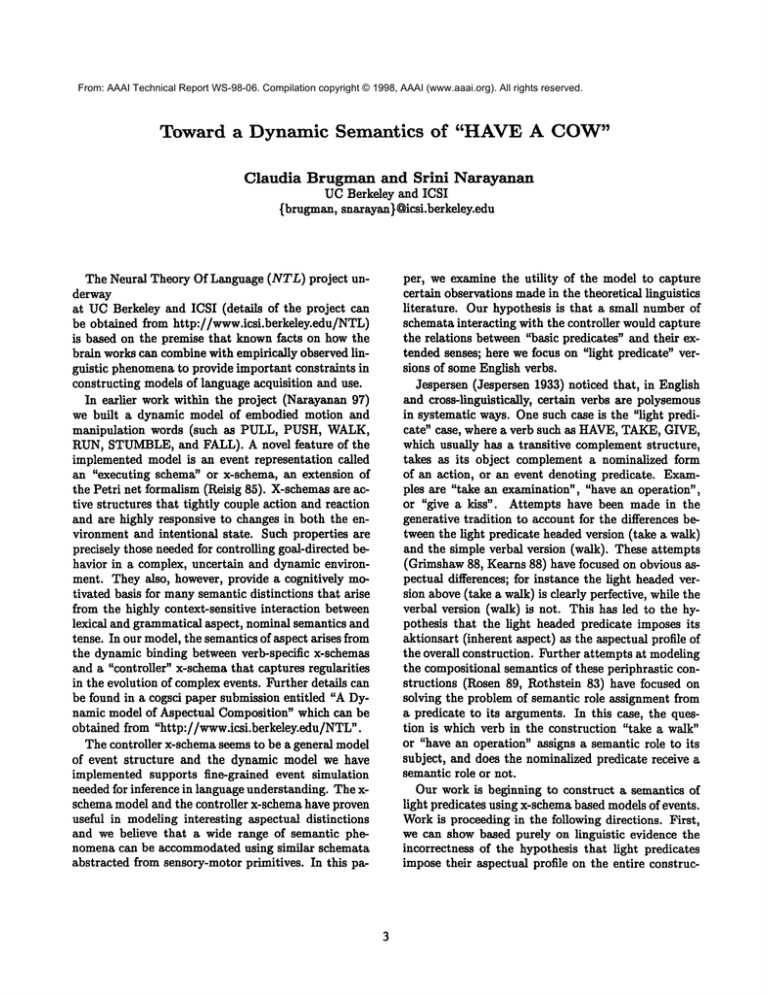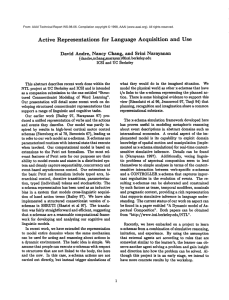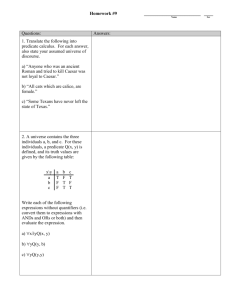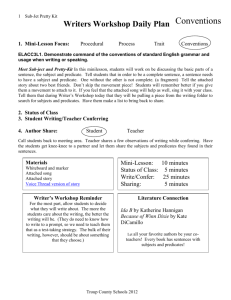
From: AAAI Technical Report WS-98-06. Compilation copyright © 1998, AAAI (www.aaai.org). All rights reserved.
Toward a Dynamic Semantics
of "HAVE A
’’
Claudia
Brugman
and Srini
Narayanan
UCBerkeley and ICSI
{brugman,snarayan } ~icsi.berkeley.edu
The Neural Theory Of Language (NTL) project underway
at UCBerkeley and ICSI (details of the project can
be obtained from http://www.icsi.berkeley.edu/NTL)
is based on the premise that known facts on how the
brain works can combine with empirically observed linguistic phenomenato provide important constraints in
constructing models of language acquisition and use.
In earlier work within the project (Narayanan 97)
we built a dynamic model of embodied motion and
manipulation
words (such as PULL, PUSH, WALK,
RUN, STUMBLE,and FALL). A novel feature of the
implemented model is an event representation called
an "executing schema" or x-schema, an extension of
the Petri net formalism (Reisig 85). X-schemasare active structures that tightly couple action and reaction
and are highly responsive to changes in both the environment and intentional state. Such properties are
precisely those needed for controlling goal-directed behavior in a complex, uncertain and dynamic environment. They also, however, provide a coguitively motivated basis for manysemantic distinctions that arise
from the highly context-sensitive interaction between
lexical and grammatical aspect, nominal semantics and
tense. In our model, the semantics of aspect arises from
the dynamic binding between verb-specific x-schemas
and a "controller" x-schema that captures regularities
in the evolution of complexevents. Further details can
be found in a cogsci paper submission entitled "A Dynamic model of Aspectual Composition" which can be
obtained from "http://www.icsi.berkeley.edu/NTL".
The controller x-schema seems to be a general model
of event structure and the dynamic model we have
implemented supports fine-grained event simulation
needed for inference in language understanding. The xschema model and the controller x-schema have proven
useful in modeling interesting aspectual distinctions
and we believe that a wide range of semantic phenomena can be accommodated using similar schemata
abstracted from sensory-motor primitives. In this pa-
per, we examine the utility of the model to capture
certain observations madein the theoretical linguistics
literature.
Our hypothesis is that a small number of
schemata interacting with the controller would capture
the relations between "basic predicates" and their extended senses; here we focus on "light predicate" versions of some English verbs.
Jespersen (Jespersen 1933) noticed that, in English
and cross-linguistically,
certain verbs are polysemous
in systematic ways. One such case is the "light predicate" case, where a verb such as HAVE,TAKE,GIVE,
which usually has a transitive complement structure,
takes as its object complement a nominalized form
of an action, or an event denoting predicate. Examples are "take an examination", "have an operation",
or "give a kiss". Attempts have been made in the
generative tradition to account for the differences between the light predicate headed version (take a walk)
and the simple verbal version (walk). These attempts
(Grimshaw88, Kearns 88) have focused on obvious aspectual differences; for instance the light headed version above (take a walk) is clearly perfective, while the
verbal version (walk) is not. This has led to the hypothesis that the light headed predicate imposes its
aktionsart (inherent aspect) as the aspectual profile
the overall construction. Further attempts at modeling
the compositional semantics of these periphrastic constructions (Rosen 89, Rothstein 83) have focused
solving the problem of semantic role assignment from
a predicate to its arguments. In this case, the question is which verb in the construction "take a walk"
or "have an operation" assigns a semantic role to its
subject, and does the nominalized predicate receive a
semantic role or not.
Our work is beginning to construct a semantics of
light predicates using x-schema based models of events.
Workis proceeding in the following directions. First,
we can show based purely on linguistic evidence the
incorrectness of the hypothesis that light predicates
impose their aspectual profile on the entire construc-
tion. Second, on semantic grounds we are extending
our earlier work on the controller x-schema by adding
the following general x-schemas: a) a source path goal
x-schema b) an object transfer x-schema and c) An energy production/consumption/transfer
x-schema. As
in our earlier work on aspect and metaphor (Narayanan
97), this requires us to work out both the computational details of the individual x-schemas and also
howvarious parts bind to each other. Webelieve that
these additions in conjunction with the existing dynamic simulation framework will go a long way toward
modelingthe semantics of the light predicate construction.
Currently, our work is at an early stage and we do
not promise to have a complete analysis of the light
predicate construction in the form of a detailed computational model by the workshop. However, even at
this stage, our analysis of not just the light predicate
construction but the auxiliary and causative uses of
HAVE, GIVE, MAKE, TAKE reveal that x-schema
based dynamic model is able to produce the positive
results of GBstyle models but describe accurately a
wider range of data. Our presentation at the workshop will concentrate on this range of data and the
properties and results of our x-schema based model.
References
Grimshaw and Mester (1988). Light Verbs and Theta
Marking, Linguistic Inquiry, 19:2, 205-232.
Jespersen (1933). Essentials o.f English Grammar.
Kearns, K. 1988). Light verbs in English, MS, MIT
Linguistics Dept.
Narayanan S. (1997). KARMA:Knowledge-based Active Representations For Metaphor and Aspect, Ph.D.
dissertation, ComputerScience Division, UCBerkeley.
Reisig W. (1985). Petri Nets. Springer-Verlag.
Rosen (1989). Argument Structure and Complex Predicates. Ph.D. Dissertation, Brandeis University.
Rothstein (1983). The Syntactic Forms of Predication.
Ph.D. Dissertation, UMass, Amherst.






